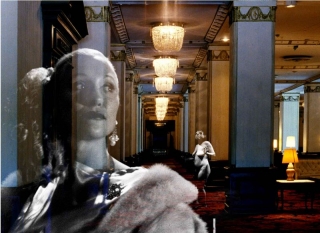Date: 31 October 2003 | Season: London Film Festival 2003 | Tags: London Film Festival
THE DECAY OF FICTION
Friday 31 October 2003, at 11:30pm
London National Film Theatre NFT1
Pat O’Neill, The Decay of Fiction, USA, 2002, 74 min
Pat O’Neill describes The Decay of Fiction as an intersection of fact and hallucination in an abandoned luxury hotel. The hotel in question is The Ambassador in Hollywood, once the grand playground of politicians and movie stars, now shabby and awaiting demolition. Against this decaying glamour, O’Neill reconstructs and reconfigures a noir-tinged narrative, in which stories slip between fact and fiction, memory and urban myth. A tall, elegant blonde stands on the terrace of her bungalow, smoking and watching the sunrise. A group of sinister men arrive and ask for Jack. Guests come and go, and so do the cops… Renowned for his brilliant and unique compositional processes using optical printing to articulate different layers in the film frame, O’Neill draws on over three decades of experimentation to compose this sensuous exploration of the boundaries of believability. (Sandra Hebron)
Screening with
Janie Geiser, Ultima Thule, USA, 2002, 10 min
An animated journey into uncharted territory. ‘A small silver plane navigates an ultramarine storm, flying over cloud-covered hills; an unlikely ferry to Ultima Thule: the farthest point, the limit of any journey.’
PROGRAMME NOTES
THE DECAY OF FICTION
Friday 31 October 2003, at 11:30pm
London National Film Theatre NFT3
ULTIMA THULE
Janie Geiser, USA, 2002, 16mm, colour, sound, 10 min
A small silver plane navigates an ultramarine storm, flying over cloud-covered hills, an unlikely ferry to Ultima Thule: the farthest point, the limit of any journey. The seduction of immersion in blue is too strong to avoid, the land fills with water, time loses its line. This film grew out of my strong attraction to a certain blue that I found in an animated film sequence. I wanted to place images in that blue rain, and an aeroplane made its way in. I followed the plane through the night storm to this unknown destination. (Janie Geiser)
THE DECAY OF FICTION
Pat O’Neill, USA, 2002, 35mm, colour, sound, 74 min
The Decay of Fiction is an intersection of fact and hallucination in an abandoned luxury hotel. The hotel is in Hollywood. The walls of the Ambassador are cracked and peeling, the lawns are brown, and mushrooms grow in the damp carpets of the Cocoanut Grove. The pool is empty, and the ballroom where Bobby Kennedy died is shuttered and locked. A tall, elegant blonde stands transparently on the terrace of her bungalow, smoking and watching the sunrise. Voices and tinkles waft across the lawn. A contingent of vaguely sinister men arrive and ask for Jack. Jack is expecting trouble, but not this kind of trouble. Louise, a guest, replays a nightmare in which she drowns Pauline so that she can marry Dean. The sun sets and rises again. Two detectives seem to turn up everywhere, searching for Communist literature and telling one another pointless stories of underworld intrigue. In the kitchens and behind the scenes the daily routine continues, individuality melts, and workers fuse with their jobs. Winter passes, and then another summer, and finally it is Halloween, and there is a costume ball which claims the life of Rhonda the evasive soprano. And then the building comes down in a clatter of Spanish tiles and concrete, and fact has finally become fiction, once again.
I scribbled the words “The Decay of Fiction” on the back of a notebook almost forty years ago, tore it off and framed it fifteen years later, and have wanted ever since to make a film to fit its ready-made description. To me it refers to the common condition of stories partly remembered, films partly seen, texts at the margins of memory, disappearing like a book left outside on the ground to decompose back into the earth.
The film takes place in a building about to be destroyed, whose walls contain (by dint of association) a huge burden of memory: cultural and personal, conscious and unconscious. To make the film was to trap a few of its characters and some of their dialog, casting them together within the confines of the site. The structure and its stories are decaying together, and each seems to be a metaphor for the other.
I am interested in exploring the boundaries of believability. The narrative tradition insists that, no matter how fantastic the story, its surface must be seamless. By contrast, I call attention to the artifice, all the staged aspects, and allow the well-worn stories to slip over and through one another. The film’s intention could be described as wanting to take stories off the screen and into the imagination. I like to work within the gaps between reality and story, to look at what is going on around the story, its context, and to make that a part of my conversation with the audience.
—Pat O’Neill
Back to top
